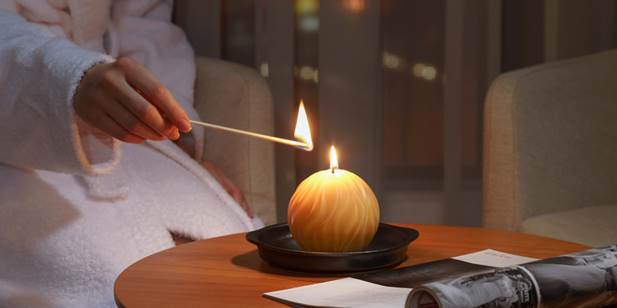Are beeswax candles really as good as they are made out to be? They can be quite expensive, so consumers may question whether they are worth the investment and wonder what benefits they truly hold. Here 8 of the most important environmental and health benefits of beeswax candles.
What are beeswax candles?
The name is pretty self-explanatory, these are candles made from beeswax produced by honeybees.
During the honey making process, bees make the wax to hold the honey. Bees produce 1 pound of wax from an estimated 33 million flowers. The wax is extracted from the honey during processing for honey and other products to be made. The wax is melted down, fragranced, rolled, dipped or set in moulds to make candles.
Beeswax has a high melting point and often a natural fragrance, but due to the high resource and time-consuming process, they can be more expensive. But are they worth the price tag?
The health and environmental benefits of beeswax candles
The natural origins of these candles can be a very attractive feature of this product. But are they really good for the environment and healthy for consumers? The answer is YES, and here are just a few reasons why.
-
Clean and Purify the air
When beeswax candles burn, the material releases negative ions into the air. These ions bond with positively charged ions and therefore, neutralises the air. The positive ions are usually particles such as pollutants, doors, dusts, pollen and other harmful airborne particles.
Neutralising the air and removing the harmful particles is connected to relieving asthma symptoms and allergic reactions. This can be especially beneficial as often asthma and allergies come hand in hand.
-
Further Benefits of negative ions
Not only do beeswax candles help pre-existing medical conditions but the negative ions have other health benefits. These include balancing and regulating serotonin levels, reduce stress and helping to regulate mood.
Additionally, these benefits can induce mental clarity, a higher sense of wellbeing and improving sleep. There are even suggestions of lighting a beeswax candle 60-30 minutes before bed to benefit from the positive effects and sleep better.
-
Lower release of pollutants
Burning a beeswax candle is shown to be very beneficial for your health, especially in comparison to other candles. Synthetic candles made from paraffin or gel release harmful pollutants and toxins into the air.
Acetone, benzene, and toluene are known carcinogens that are linked health and environmental damaging effects. Including cancers in the lung and cardiovascular problems. As well as petro-soot that is similar to fumes released by diesel cars.
Therefore, cleaner burning beeswax candles will be much more beneficial for the environment and your health.
-
Natural Light emitted
Another comparison between manmade and beeswax candles is the light they emit. Synthetic paraffin wax candles tend to burn weakly due to a lower melting point.
On the other hand, beeswax candles burn much more brightly, emitting light on the same spectrum as the sun. Providing such a bright and ambient light can often contribute to helping Seasonal Affective Disorder (SAD).
-
Sustainable Materials
Paraffin wax candles are made using the sludge at the bottom of crude oil barrels, and bleached for its white colour. Promoting the use of unsustainable fossil fuels and explaining why so many toxins are released when burned.
Although, more sustainable soy wax candles are also available, they require hydrogenation (a chemical process) in order to be made. Additionally, soy wax may be made from a plant but has damaging environmental and social implications such as deforestation and pesticides.
This is what makes beeswax candles a much more attractive and environmentally friendly option. Beeswax is a natural by-product of honey making and doesn’t require any chemical process or additives to make the candles. The wax is also biodegradable and burns slower than most other candle wax, making it last even longer.
-
Naturally scented
In addition to the main wax being harmful to health and environment, the scents added can also cause the same effect. Synthetic fragrances release phthalates that can aggravate asthma and allergic reactions when inhaled.
Beeswax candles on the other hand are scented naturally. The scent of beeswax candles can also change with the type of bee and the flowers they visit. Some candles may be also scented by using natural essential oils that do not cause any reaction like synthetics. Therefore, maintaining the health and environmental benefits for beeswax candles.
-
Natural Wick materials
Another material that can also emit toxins is the wick of a candle. Historically, wicks contained a lead core which released lead particles in to the air causing poisoning. Even though nowadays lead cores are mostly banned, zinc is a common replacement, with synthetic fibres used as wraps.
Most natural candles instead, use cotton or paper wicks with no metal core. Using a sustainable and natural material will not release any harmful particles into the air, thus protecting your health.
-
Supporting Local beekeepers and businesses
Another great benefit of investing in beeswax candles is that it supports local beekeepers and businesses. As beeswax is a by-product of the honey industry, making beeswax candles can be a great way for local businesses to add to their potential income.
Final Take aways on beeswax candles
Beeswax candles have many benefits for the environment and your health. From cleaning the air and producing negative ions that promote good health. To bright light like the sun and being made from sustainable materials.
However, it is clear that simply purchasing a candle stating it was made with beeswax is not all that is needed to ensure you receive these benefits. You should ensure that the candle you are purchasing is 100% beeswax, unscented (or scented with natural oils) and has either a cotton or paper wick.
In burning your 100% beeswax candle, you can be sure that no harmful substances will be released into the air, as well as knowing you are supporting both the environment and local businesses.


















